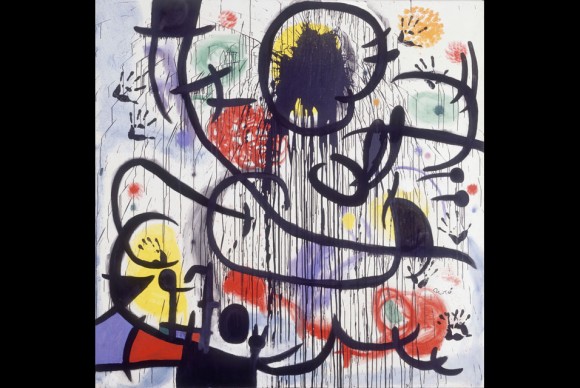First Major Retrospective in 50 Years of Spanish Artist Joan Miró Opens at Tate Modern
LONDON.- Tate Modern presents the first major retrospective of Joan Miró (1893–1983) to be held in London for almost 50 years. The exhibition is on view from April 14 through September 11, 2011. Joan Miró: The Ladder of Escape brings together over 150 paintings, works on paper and sculptures by one of the twentieth century’s greatest artists. The exhibition draws on collections from around the world to represent the astonishing breadth of Miró’s output. It also explores the wider context of his work, bringing to light the artist’s political engagement and examining the influence of his Catalan identity, the Spanish Civil War and the rise and fall of Franco’s regime.
Miró was among the most iconic of modern artists, evolving a Surrealist language of symbols that evokes a sense of freedom and energy in its fantastic imagery and direct colour. Often regarded as a forefather of Abstract Expressionism, his work is celebrated for its serene, colourful allure. However, from his earliest paintings onwards, there is also a more anxious and engaged side to Miró’s practice, reflecting the turbulent political times in which he lived. This exhibition explores these responsive, passionate characteristics across six decades of his extraordinary career.
Joan Miró: The Ladder of Escape examines the artist’s varying degrees of engagement over his lifetime. These are rooted in the complex identity politics associated with Catalonia, as revealed through Miró’s representation of its landscape and traditions. These depictions range across images of rural life, such as The Farm 1921-2 which Ernest Hemmingway bought from the artist in Paris, to the masterly sequence of the Head of a Catalan Peasant 1924-5. The tensions that erupted with the Spanish Civil War in 1935-9 elicited Miró’s explicit protests in Aidez l’Espagne and Le Faucheur 1937, as well as more private and troubled responses disguised in the renowned Constellation paintings of 1940, made in the Second World War.
Under Franco’s regime, Miró worked in a kind of internal exile in Spain while cultivating a reputation abroad as a hero of post-war abstraction. Joan Miró: The Ladder of Escape showcases masterpieces from this era, including the sublime The Hope of a Condemned Man triptych 1973. The exhibition also reveals how he captured the atmosphere of protest in the late 1960s. Whether blackening or setting fire to his works, such as May 1968 and Burnt Canvas II 1973, or creating euphoric explosions of paint in Fireworks 1974, Miró continued to reflect the political mood in his radical and pioneering practice.
Joan Miró i Ferrà was born in Barcelona on 20 April 1893 and trained as an artist at the Galí Academy from 1912-15. From 1923, he spent part of each year in Paris and became a key figure in the Surrealist movement. With his young family he remained in France during the Spanish Civil War, but returned to Spain when the Germans invaded in 1940. Miró settled in Majorca and remained based there for much of the rest of his life, travelling for major commissions and exhibitions around the world. He died at home on 25 December 1983.
Related posts:
- Palestinian-British Artist Mona Hatoum Announced Winner of the 2011 Joan Miró Prize
- A Journey Through British Art from World War II to the Late Sixties at Fundació Joan Miró
- Second Cycle of Exhibitions for Espai 13 at Fundació Joan Miró Opens with Marcus Coates
- Retrospective of the Leading Mexican Artist Gabriel Orozco on Display at Tate Modern
- Francis Alys: A Story of Deception Opens at Tate Modern

